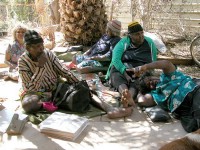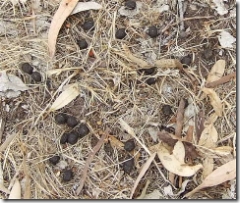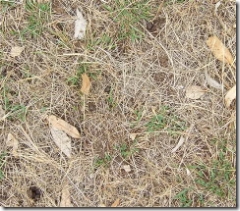


The familiarity of working with plant materials straight from the earth certainly makes one more observant of states of growing and decay.
The photographs of leaf litter, grass and manure tells me that this would be ideal material to make something from. And if I combined it with the farmers words of concern it could lead me to intersting corners of the paddock.Particularly when the grass is slightly dampened with rain. Its a perfect opportunity.
This leads to that idea of linking the two cultures of the West as you name it. Colonial and Indigenous.
There are points of contact which have helped me to develop this way of seeing. First of course is my childhood development in rural West Australia , the make do concept of which my father was a great proponent.
Then when I began making fibre baskets (1979 age 34) It was as the exploration of plant materials actually sited in the bush. I went to where plants where growing and sat there sewing.This was far afield, the Goldfields, the Pilbara, the wheatbelt, a woman sitting under a tree sewing, now how much thinking time does that constitute. (The first picture here is a basket made in 1983 from mallee bark rolled around grass in a continuous length and stitched with linen thread whilst sitting in Goldfields landscape.)
Then doing academic studies at Curtin University gave me an intellectual framework and developed drawing and painting skills.
In 1991 I was invited to become invovled with Indigenous women through the Healthways project in Kalgoorlie.
This is really an important time because I started to learn Ngaanyatjarra language from Pantjiti Mary Mclean a Ngaatatjarra woman. Mary is one of those people walked from the Western Desert to Mount Margaret Mission in the early 50's.
We have a very close friendship and to this day she speaks in language to me most of the time.
Though she resides in Kalgoorlie, my birthplace, her people live in the Western Desert, Warburton Ranges, Blackstone, Jamison , Docker River and Mtutijulu.
As with many older people removed from their land she does not openly reference cultural practices however the very act of us spending so much time together and connecting with all her relations meant so much has rubbed off on me in other ways.
It is very complex. At this point indescribable. (The second image is Mary and I at Curtin University 2001)
However coming to understand so much more about naming, words,practices, responsibilities, inequities and opportunism certainly slowly showed me a what I had the skills and werewithal to pursue.
And that is still only part of it, probably the knockabout life I have lead is mostly responsible for the at least the way I think deductively.
Understanding Ngaatatjarra language (in a very modest way) has been like the map of my mind was completely renamed.
It is both liberating (cant get lost), confronting (where do I belong) and a privilege (responsibility of being privy to words).
You can see I was a dead ringer to be a maker of ideas with all this lot inside my head.
Though materials have been the major language of my work, whatever is at hand (lifestyle) is fair game for me, moving from native plant material, (an enviromental issue) to fodder ( a colonial issue) is an exciting step for me.
There are other materials which are used repeatedly, for instance, seeds, bracts, leaves and it is the meaning intepreted through these that can be read. All of these things combined with used clothing and fabrics comes close to expressing what I think needs to be stated.
With regard to workshops, there are broadly speaking two strands of reasons women are drawn to participate in them.
First is the desire for opportunity and second is the desire for information, with an intemediate strand containing portions of both.
I have found that Aboriginal women are enthusiastic to be given the opportunity to make baskets etc,
Thisbe found this also in her early days of getting basketry going with the Western Desert women. You have been to the grass event at Alice Springs where it was this amazing nest of women, grass and coloured raffia. Even though there were many non Aboriginal women there , they were learning simply by sitting observing what the Minymas (women) were doing. (The third photo is Mrs Benson with women at the workshop)
Whereas if I do a workshop with non indigenous women then it is a mixture of history, techniques, materials, and potential outcomes. It is expected to be like that and it seems to be highly liberating for many.
When FORM did the Cultural Strands workshop in Kings Park last year, 100 women came and we had bales of fodder opened in the centre of it all, all these women, hopped into it with only very basic information. Their forms came naturally, so perhaps as much as anything it is the many different materials which it make it difficult to understand in regular workshops. This points to our desire for diversity. Where as the Aboriginal women from the remote communities have to be satisfied with grass and colour, sometimes feathers, wigs etc.But always grass.
I am curently stitching the red lining I remvoed from the red dress. It is a flimsy worn garment. I am stitching ininti beans across the top of it. Dreaming of dance. its an appropriate follow onto the way its outer covering was used. The outer and the inner.









